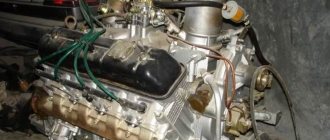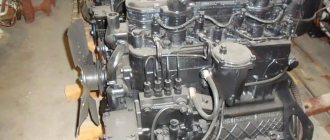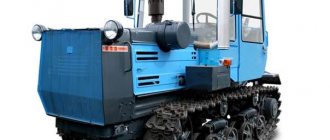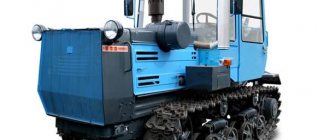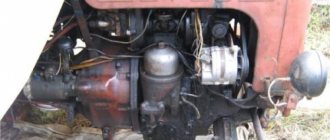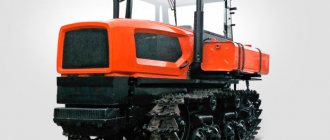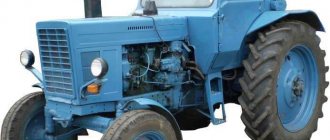The UMZ 421 engine is based on the design solutions of the previous 417 series and the GAZ 21 engine. The prototype, labeled 4218.10, was completed in 1983, but it was refined for another three years. After which, the designers worked on version 241.10 with the original shape of the exhaust tract.
ICE UMZ 421
Then 8 more modifications were added with increased power, compression ratio, deformed, with a different camshaft, complying with Euro-4 standards and two gas-gasoline options. As a result, the 421 ICE line is produced to this day; it is equipped with cargo and passenger Gazelles, Sobols, Barguzins and Hunter SUVs, and cargo-passenger UAZ “Loaves”.
UMZ 421 engine: technical characteristics
The new UMZ 4215 engine began production in 1993. In the updated configuration, the unit develops a power of 98 hp, and the crankshaft rotation speed reaches more than 4000 rpm.
Main technical characteristics of the motor:
- Type of injection system - carburetor and injector, depending on the modification. For example, modification 4213 had an injector.
- The cylinder block material is aluminum, it is lighter and cools better.
- The configuration or arrangement of the cylinders is in-line, classic.
- The working volume of the combustion chamber is 2890 cubic meters. cm.
- The maximum piston stroke is 92 mm.
- Number of cylinders – 4.
- Compression ratio – 8.2.
- The weight of the engine is relatively small and amounts to 170 kg.
This internal combustion engine runs on 92 gasoline. A distinctive feature of the family is its environmental class. In the presence of a catalyst, it provides at least EURO-4 even on 92-octane gasoline. Also, the modification with an injector has relatively low fuel consumption. It requires no more than 11 liters per 100 km. As for the resource of the power unit, it is quite large and amounts to at least 250 thousand km according to data provided by the manufacturer. In practice, such a motor has proven itself to be durable, so it is able to work longer than the specified period.
Engine tuning options
Since the UMZ 421 family engine is designed for heavy trucks, minivans, off-road and all-terrain vehicles, utility vehicles, atmospheric tuning by mechanical means does not even make sense to consider. But it is quite possible to install an urban quiet type turbine. To do this you need to follow these steps:
- replacement of standard injectors with 440CC modifications from the manufacturer Subaru;
- modification of the intake manifold to integrate an intercooler;
- grinding of combustion chambers and channels inside the cylinder head;
- ShPG and shafts remain standard;
- Instead of a combined exhaust tract, a direct-flow spider 63 mm in diameter is mounted.
Turbocharger for UMZ 421
After flashing and tuning, tuning can add 30 - 50 hp. sec., the engine becomes “tractor-like” and has powerful torque in the lower speed range.
Thus, the 4218.10 motor with a very average resource due to defects in the casting of the cylinder block is considered to be the base motor in the series of the manufacturer UMP. But in all subsequent versions, not only this defect was corrected, but also other design solutions were used to improve performance and service life.
If you have any questions, leave them in the comments below the article. We or our visitors will be happy to answer them
Main modifications of UMZ 421 engines
All modifications of this family of motors can be roughly divided into 2 categories. The first will include those that run on low-octane gasoline. These are UMZ 4213, UMZ 4215 and run on gas gasoline. The latter include modifications 421800. There was also a modification with increased power with an aluminum cylinder head - TsMZ 4216 99 hp.
All modifications of the motor from the 402 series:
- UMZ 4218.10, UMZ 4215.10-10, UMZ 4215.10-30 - the main modification of the internal combustion engine with a compression ratio of 7, was developed for 76 gasoline. The power did not exceed 98 hp, and the environmental class was no more than EURO-1.
- UMZ 4218.10-10 - The internal combustion engine is similar to the UMZ 4218.10, but it has an increased compression ratio to 8.2 for 92 gasoline, respectively, and more power by 5 hp.
- UMZ 421.10 - the motor is an analogue of the UMZ 4218.10, but is equipped with a modified gas exhaust system.
- UMZ 421.10-30 is essentially a complete analogue of UMZ 4218.10-10, but with a modified exhaust system.
- UMZ 4213.10-40, UMZ 4213.10-50 - a model similar to UMZ-421.10-30, but with an installed injector. Thanks to it, the environmental class has been increased to Euro-3, and the power has been increased to 117 hp.
- UMZ 4216.10 UMZ 40215.10-30 is an injection unit with an increased compression ratio to 8.8, adapted to run on 92-octane gasoline and has increased power up to 123 hp.
- UMZ 42161.10 - a model similar to UMZ 4216.10 with a power of 99 hp.
- UMZ 42164.10 is an analogue of UMZ 4216.10, but is equipped with an improved camshaft and a modified exhaust gas system. Its environmental class is Euro 4, and its power is 125 hp.
- UMZ 421647.10 – improved modification of UMZ 42164.10, gas-gasoline with a power of 100 hp.
- UMZ 42167.10 and UMZ 42161.10 – taxes UMZ 4216.10, are gas-gasoline units with a capacity of 123 hp
Installation
Car owners often do the work themselves using garage tools. After the owner has decided which carburetor is better for the 421 UAZ engine, the device is installed. The carburetor on the UMZ 421 is no exception, especially since replacing the standard device will not be difficult. For a smooth ride, it is necessary to make the gas pedal mechanism a cable mechanism, and also redo the choke rod.
Modifications to DAAZ will require more intervention. The mounting holes do not line up with the studs on the intake manifold, which makes installation very difficult for inexperienced technicians. The accelerator and choke mechanism also need to be redone; there are ready-made options for auto analysis.
Before installing a used carburetor on the UMZ 421, you must thoroughly rinse the body and internal parts and replace all seals. It is not recommended to install jets from a repair kit; it is best to select the size after installation on the motor. There are many varieties of Solex fuel mixture supply systems. Not all models are suitable for the parameters of the UAZ; it is important to study the design features before installation and the compatibility of components.
Description of the valve adjustment process on the ZMZ 421 engine
The procedure for adjusting the valves occurs in the following order:
- Stop the engine and let it cool.
- Remove the vacuum regulator tube.
- Remove the cylinder head cover, first stock up on a new gasket and sealant.
- Install the piston of the first cylinder according to the TDC mark located on the crankshaft pulley. The valve must be closed.
- Check the gap between the valve and the rocker using a feeler gauge with a plate thickness of 0.35 mm. It should go in with little effort.
- Adjustment is made by loosening the locknut and turning the adjusting bolt to the right or left.
- After setting the gap, secure the bolt with a locknut.
- Rotating the shaft 90 degrees, make adjustments in cylinders 1, 2, 4 and 3.
- Install the new gasket and cylinder head cover in place.
Crankcase ventilation
The motor is equipped with a closed crankcase cavity ventilation system. Part of the gases passing through the compression rings is discharged into the intake manifold using a combined method. The work of the accounting software complex is carried out due to the pressure difference between the crankcase and the intake tract. Just when the 4216 engine is running at high loads, the gases are vented through a special huge branch.
The small branch removes gases when the unit is running at idle speed and at low loads.
Advantages and disadvantages of UMZ 421 engines
The Ulyanovsk Motor Plant offered a large line of new engines, but the main problems were not eliminated. Moreover, with the introduction of innovations, new defects have arisen that require regular intervention. As for the advantages, they include:
- ease of repair and maintenance;
- unpretentiousness in choosing oil;
- availability and low cost of spare parts;
- The service life of the UMZ 4218 motor has been increased due to the use of thin dry liners and the displacement of the pin.
Flaws:
- All UMZ 4215 motors are not able to withstand overheating. After it you have to change the cylinder head.
- Lack of power in the UMZ 4213, which was never enough to achieve normal bus dynamics.
- There are no hydraulic compensators, which means you have to adjust the valve clearance every 10 thousand km.
- Increased fuel and lubricant consumption.
- Possibility of mixing oil with antifreeze after a run of 10 thousand km.
List of car models in which it was installed
Until 2005, most of the internal combustion engines of the Ulyanovsk Motor Plant were used by several car manufacturers. The UMZ 421 engine, which equipped the vehicles, was no exception:
- SUVs UAZ Hunter, Patriot, Bars, 3160,3161;
- all-terrain vehicle Simbir 3162, Tiger 2330;
- Pickup trucks, Cargo, 39095;
- minibuses 2206, 3303, 3741, 3909, 3962, Simba 3165;
- onboard Gazelle 3302;
- cargo-passenger Gazelle Farmer 33023;
- frame vans GAZ 2705;
- minibuses Gazelle 3221;
- vans and minibuses Sobol 2217;
- minivans Barguzin 2217.
Bus GAZ Simba
For two plants, the engine characteristics were ideal, but for the Gazelles the radiator and fan had to be moved in height.
Features of maintenance of 421 engines
Opinions about performing maintenance on a car with a ZMZ 421 engine vary among different owners. In fact, it all depends on how it is used and in what modes it operates. If the car often overcomes off-road conditions, and the engine operates under increased load, then it is recommended to adjust the valves before the mileage of 10 thousand km.
Signs that valve adjustments may be necessary:
- A noticeable decrease in the power of the unit.
- Feeling of tapping sound from valves that is uncharacteristic of normal operation.
- Flashes appear periodically inside the carburetor.
- Popping sounds are heard in the exhaust system area.
- When adjusting valves, you need to take into account the peculiarities of its operation. The gap in cylinders 2 and 3 should be from 0.35 to 0.4 mm.
- Scheduled maintenance consists of the following types of work:
- Changing the oil, oil filter and valve adjustment - every 10 thousand km.
- Maintenance of the exhaust manifold, fuel rail, fuel line and spark plugs - every 20 thousand km.
- Replace the air filter after 30 thousand km.
- Replacement of fuel filter, antifreeze - 40 t. km.
Supply system
It consists of a fuel supply device and various fuel lines, injectors, fuel and air filters, air supply pipes and a receiver, and an idle air regulator.
The fuel supply is controlled using various sensors: charge air temperature element, crankshaft and camshaft position sensors, absolute pressure part, throttle valve position. The supply control system is also equipped with an oxygen indicator. The latter is installed in the exhaust system in front of the converter. For greater reliability and durability, the 4216 engine (injector) should run only on high-quality gasoline, taking into account the constant replacement of fuel filters and repeated diagnostics of fuel equipment. Motorists say that with proper operation, the total resource of the unit sometimes reaches 500 thousand km. The injection systems of the Zavolzhsky Motor Plant are also distinguished by this feature (there are ZMZ 405 and 406 engines).
Description of the most common problems with 421 UMZ engines
The 402 series motors cannot be called ideal, but they are easy to repair and their maintenance is inexpensive. Over the entire period of their operation, car owners have encountered many problems, including the most common:
- possibility of oil penetration into the coolant;
- almost constant instability of operation in idle mode;
- after 5-10 thousand km there is a decrease in power;
- There is a knocking noise from time to time in the crankshaft bearings.
Gas distribution mechanism
In 2010
At the Ulyanovsk plant, the gasoline engine underwent the process of modernizing
the gas distribution mechanism
. As a result, this affected the configuration of the camshaft cam profile, which contributed to an increase in valve stroke by one mm. These innovations were needed to improve the stable operation of the unit at idle, as well as to meet the standards and requirements of the Euro-3 standard.
The valve springs did not undergo changes at the same time, and this situation led to the fact that the acting force on the springs crossed the norm, now being equal to 180 kgf. During the process of installing a regular set of rods on a new engine, until the engine was warmed up, knocking noises from the hydraulic compensators were heard.
To be able to prevent this problem, you should change the spring force by dismantling the internal valve springs.
We install the DAAZ carburetor on UAZ cars
Since Soviet times, UAZ cars in various designs and modifications are rightfully considered one of the most popular Russian SUVs. They are distinguished by their unpretentiousness, accessibility and ample opportunities for repairs on their own. Since these cars - especially older models - are not very economical, many are thinking about the question: how to replace the standard carburetor of a UAZ 31514 or another model?
How to reduce fuel consumption while maintaining excellent driving performance of the car? At the same time, a sufficient number of owners of UAZ cars have already decided these issues for themselves; the Internet is replete with numerous reviews about installing a variety of carburetor models on their UAZ 31514 or UAZ 3303. Let's consider possible options for replacing carburetors from different manufacturers, such as PeKar (carburetor plant , St. Petersburg) and DAAZ (Dimitrovgrad Automobile Assembly Plant).
Fuel consumption
Theme Options
- print version
Fuel consumption
So a little about fuel consumption, what, why and how does it depend? As a rule, the question of consumption begins to arise when deviations from the manufacturer’s declared consumption in the car’s passport begin to deviate by 50% or more and not at all in the direction of decrease, what needs to be looked at and checked? Let's start with the often asked question: why is it that when I stand still the instantaneous consumption column is at its maximum, but if I reset the average consumption readings on the on-board computer it shows 100l/100km?!
It’s all just a computer dividing the fuel consumed by the kilometers traveled on the odometer. When the car is started, it consumes fuel, but the mileage is zero, i.e.
roughly speaking, 1 liter of gasoline burned in an hour, drove zero km (we’re standing still!) divide 1 liter by zero (they taught us not to divide by zero at school, so they lied to us! Or rather, they didn’t tell the truth, you can divide by zero!) it turns out infinity but because The computer has “infinity” programmed in the form of the figure 100 liters, and it shows this figure. Fuel consumption depends on many factors,
let's start: From
the driving style,
if you are a “racer” in life, then the consumption can easily be 1.5 or even 2 times more, the factory figure for the average urban consumption is given under the condition of driving like an old man, i.e. e.
without starting with a trail from a traffic light and the brake pedal to the floor at the next traffic light, smooth acceleration and smooth braking with coasting. For reference, instantaneous fuel consumption when the pedal is pressed to the floor (i.e. at the given second when the pedal is pressed) for an engine with a capacity of 1500 cm3. is 40-60l/100km (maybe that’s why the P12’s consumption column ends much earlier, so as not to shock the driver with “horse consumption”) From the serviceability of the car.
Consumption is affected primarily by
the condition of the engine, its wear, as well as the serviceability of fuel supply systems and sensors.
For example, a faulty lambda probe or mass air flow sensor can increase consumption by 50-150% (although, for example, a lambda probe in good condition can affect the composition of the air-fuel mixture within 15%) But not only the condition of the engine affects consumption, oddly enough, Tires also affect consumption.
for example, consumption on summer, “motorway” hard tires is less than on winter ones and the difference can be up to 1 liter/100 km when changing all 4 tires from summer to winter and back. This is due to the fact that winter tires have more developed lugs ( experiment
: ride a bike with road tires and a trial bike at the same speed, for example at 3rd or 4th, to feel the difference) which have greater rolling resistance, in addition, winter tires are made As a rule, it is softer than the summer one (so as not to “flatten” in the cold) in order to compress and straighten the tire to a “round” state, energy is needed (
experiment:
ride a bicycle with half-flat and inflated tires at the same speed).
For the same reasons, the tire pressure
should be the same and equal to the value specified by the factory (usually 1.8-2.0 Atm for P12, everything is indicated on the label on the door pillar).
an overinflated tire rolls easier ( experiment:
inflate a bicycle tire 0.5 atm more than required and it will roll), this is true, BUT the average treadmill wears out much faster than the rest of the tire and instead of 50-60-70 thousand km you drive 20-30, then It’s up to you to either save gas and drive on an overinflated tire, or save tires and drive at normal pressure recommended by the factory. The difference in pressure between tires on one axle of 0.1 atm below that recommended by the factory gives approximately 0.1 l/100 km of consumption as a plus.
Transmission
- a car with an automatic transmission consumes more fuel than a manual one, the difference is 0.5-1 liters depending on the engine size and transmission type (automatic, CVT).
Further weather conditions
, naturally they affect the consumption, and this is obvious, well, for example, a headwind increases the consumption, a tailwind reduces it, with a headwind the consumption increases according to the same law “square of speed = air resistance”, just like in calm weather, you just need to add speed to the speed of the car headwind.
With a tailwind, everything seems to be clear, too; it “pushes” the car and helps the engine accelerate the car until the car begins to move faster than the speed of the tailwind and there will be no “savings” from such “help.” Rain/ice also increases fuel consumption, due to reduced traction the wheels slip and naturally consumption increases (in an extreme case, the car is stuck in a hole, the wheels are spinning, the car is not going anywhere, the fuel leaves the tank and the kilometers do not increase). Air temperature
also affects consumption approximately at +30C and at -15C, the difference in consumption can reach 1-1.5 liters, this is due to the fact that with a decrease in temperature, the lubricant in all components thickens (even during a trip, due to “better cooling "in cold weather, the same CV joint or lithol have a higher viscosity and, as a result, bearings and shafts spin harder.
External factors
also have an influence; various kinds of body kits, spoilers and other necessary attributes of racing cars are selected and calculated there, tested in a wind tunnel for maximum stability and car handling on the race track, but not at all for fuel economy. The effect of these “spillies” is difficult to assess, but we conducted such an experiment: a classic Lada with a roof rack consumes approximately 0.1 l/100 km more than without a rack. Also, consumption naturally depends on loading a car, it is clear that carrying 1 person with 80 kg and 5 people with 80 kg + 50 kg in the trunk (total 450 kg) are different things (
Experiment:
ride a bicycle alone and put another such person on and compare the difference in effort).
Driving speed and driving conditions.
The fact that consumption in the city cycle is higher (traffic jams, traffic lights, frequent engine starts, warm-ups) than on the highway is, I think, obvious to everyone and this consumption can easily vary by 2 times.
the speed of movement, here is a well-known fact from physics: the drag of air as the speed increases is proportional to the square of the speed, many have heard this. As an example, I will give an experiment +20C, clear, dry, windless: - engine 1.6 manual transmission 5th gear at 90 km/h consumes 5.8 l/100 km at 180 km/h 10 l/100 km/h speed 2 times and consumption also 2 times and another example at 60 km/h engine 1.6 manual transmission 4th gear consumption 6.2 l/100 km/ at 90 km/h consumption 5.8 l in 5th gear. Conclusion
you need to move at the optimal speed (usually 85-100 km/h and gear (for the indicated speed the manual transmission is 5th) Now let's talk
about high...
no, not about spirituality... but about
consumption...
what do you mean by high, large, huge consumption? to determine, first you need to
CORRECTLY MEASURE FUEL CONSUMPTION.
how to do this. 1. If you have any suspicions that the “horses are greedy”, do the first preliminary test measurement: - Reset the “fuel” maps to factory values - Reset the computer indicating the consumption to 0 - we go out onto the highway and drive at a speed of 85-95 km/h without sudden acceleration and braking (yes, you’ll have to throw up like an old man, but where to go?) After 100 km (more is better), look at the computer readings if the consumption is within +-0.5 -1 liter from the passport, turn on the head, put the “slipper on the floor” ... if it is still confirmed that the “horses have gone crazy” then we make a real
accurate measurement of the flow rate
, choose a quiet, clear day (ideally a summer day with a temperature of +20+25C). Do all this Naturally, you need one without passengers and cargo. The route is preferably not heavily loaded with cars and more or less flat without long descents and ascents. -Fill the tank full under the neck. -We also pour gasoline into a canister that we took with us in advance (preferably as much as approximately will be consumed, i.e., with a planned mileage of 100 km and a consumption of 15 liters, at least 15 liters, i.e. 20k should be taken). -We reset the “fuel” maps (yes! yes! again, because they are adjusted by the “brains” (ECU) of the car depending on the quality of the fuel and engine operating modes) to factory values -Check the pressure in the wheels. We start and go to the highway, preferably one that is less loaded with cars. so that you can maintain a speed of about 90 km/h (-+5 km/h). Having driven out onto the highway, we again fill the tank from the canister under the cap. -We’re all driving along the highway at 90 km/h, preferably at least 100 km (more is better) and it’s better to roll back and forth so that all the ups and downs add up and average out. On the descents, roll up, and naturally they will not accelerate more than 100 km/h, but do not turn off the engine from the gearbox if you have a manual transmission. in this case, fuel consumption is higher (yes! yes, the ECU does not cut off the fuel supply to the engine during forced acceleration), on climbs it is also advisable not to reduce the speed to less than 80 km/h. But again, not “pedal to the floor”, but smoothly with a slight tension t .e. do not wait until the speed drops to 80 km/h and then “accelerate”, but “resist” the engine a little when the speed is just beginning to decrease from 95 km/h to 94 km/h, etc. At the same time, it is not harmful to look at the instantaneous fuel consumption and keep it between 10-15 l/100km. It will turn out to be quite “old man vomiting.” What did you think?! Pedal to the floor and fuel consumption low?
Then we drove 100 km according to the odometer, we refueled again under the traffic jam, BUT now FROM A MEASURING CONTAINER (the measuring container cannot be a 3-liter jar or, especially, a 10/20 liter canister; the container needs to be accurate to 100 ml, something from laboratory vessels). After refueling, divide the measured volume by the kilometers traveled to obtain the consumption. SO: On a quiet summer day at +20C..+25C on summer tires on a dry road and a working car, without air conditioning (and heater) you should get something like this: plus minus 0.5l 1.6 manual transmission: 5.8-6.3l Manual transmission 1.8: 6-6.5l automatic transmission 6.5-7l manual transmission 2.0: 6.2-6.8l variator 6.5-7.5l if the numbers are significantly higher under the same conditions on the highway (well, let’s say by 25% and higher) then we need to look for the reasons for the really high consumption. For the city, the result obtained for summer with air conditioning is multiplied by 1.5 for engines 1.6-1.8 and multiplied by 1.7-2.0 for 2.0 s variator. For winter, lower temperatures, winter tires, a large number of electrical consumers, which put a load on the generator, which in turn on the engine can increase the consumption of the summer 2 times (for example, 1.6 manual transmission in the city at -30C with warm-ups and naturally the stove, heated mirrors, seats and headlights gives 12-13l/100km, now compare its summer consumption in the city around 8-9 liters... and now estimate how much the QR20 eats at -30C in this mode and the figure of 18-20l/100km will not seem so unrealistically overpriced and even more so far from the passport) If you have taken all the measurements and the result is “still eating!” welcome to the topic and write in detail what you measured, what you checked and how, then perhaps they will be able to advise you on something. Well, here’s a picture of the “little things” that affect consumption Attachment 80646
Piston group and crankshaft
Due to the increased rigidity of the block, it was possible to somewhat reduce the uneven wear of the cylinder mirrors, which increased the service life of the cylinder-piston group. The mass of the piston was reduced in order to reduce the forces on the side of the piston. This was achieved by reducing the distance from the piston pin axis to the piston crown by 7.5 mm. To compensate for this distance, the length of the connecting rod is increased by 7 mm. Pistons are cast aluminum with a high silicon content. Part of the combustion chamber is located in the piston bottom (a recess in the shape of a truncated cone).
The crankshaft is cast iron. The main journals have a diameter of 64 mm, the connecting rod journals have a diameter of 58 mm. The flywheel is fixed on the rear part of the shaft, and the cast iron camshaft drive gear and pulley hub are fixed on the front part. In order to prevent axial play of the shaft, two washers are installed on the front main bearing. Instead of the outdated packing, the rear part of the UMZ 421 crankshaft is sealed with a self-clamping rubber oil seal. This solution made it possible to get rid of a long-term problem inherited from ZMZ - oil leakage through the packing.
A little history
In the wide open spaces of Russia, you can still often find Soviet SUVs of the UAZ 469, 469B and 469BG models (military, civilian and medical, respectively), the production of which began back in 1972. They are the predecessors of the current UAZ 31512 and 31514 models, which appeared as a result of modernization in 1985, which are still successfully serving today. In the same way, the onboard UAZ 452D in 1985 became the UAZ 3303.
The UAZ 469 model had a standard single-chamber K 131 carburetor, which is currently morally and physically outdated (it is practically impossible to find it in good condition). Subsequently, with the advent of newer engines, the K 126 carburetor appeared, and the UAZ 31512 and 31514 models received the new PeCar K 151, which is equipped with many other Russian-made cars (Volga, GAZelle, Sobol, and so on). All of the above carburetors were produced by the Leningrad Carburetor Plant. Our task is to consider the possibility of replacing them with units from another manufacturer (DAAZ).
Brief overview of carburetor models
Here is an overview of the models of units produced by DAAZ, suitable for installation on Ulyanovsk SUVs.
- DAAZ 2101/02/03 WEBER. It is impossible not to mention this predecessor of OZON carburetors, which works wonderfully with UMZ engines with a displacement of 2.4 liters installed on the UAZ 31512. WEBER is not as economical as its newer Dimitrovgrad counterparts, but in terms of traction characteristics it produces excellent results. Fuel consumption is slightly lower compared to K 131 or K 126. The disadvantage of the unit is that it is difficult to find in working condition. Typically, you need to find two or three old Webers to assemble one working one.
- DAAZ 2107 OZONE. A very suitable option for those who do not care about overclocking dynamics. Fuel consumption on the UAZ 31512 model after installing the 2107 carburetor is noticeably reduced. We deliberately ignore the second modification of OZONE - DAAZ 2105, which is designed for a much smaller engine displacement.
- DAAZ 2140 OZONE is an analogue of 2107 with a different set of jets and a less successful idle system. Suitable for installation if you already have it in stock, but if not, it’s better to purchase 2107.
- DAAZ 2108 SOLEX, DAAZ 21073 SOLEX. The first is designed for VAZ cars of the eighth and ninth families, the second is installed on the VAZ 21213 Niva. Solex carburetors are complex and high-tech products; their installation on the UAZ 31512 is completely justified, as it gives good results. Preference should be given to modification 21073, which has larger diffuser sizes. Both modifications are equipped with EPHH with electronics, so when installed on older machines, some modification will be required to connect it. In other cases, the electronic system is simply discarded, but this affects the efficiency of the car.
- DAAZ 4178 SOLEX. Among the carburetors of the Dimitrovgrad plant, it is the most adapted for UAZ cars; it is perfect for both the UAZ 31512 and UAZ 3303 models. It can also be installed on older cars (before 1985). Reliable, economical, easy to install, and has the largest number of positive reviews from admirers of the brand.
Return to contents
The lineup
UMZ 4216 engine At first, however, drivers and service employees were hostile to the newcomer; they had simply become accustomed to ZMZ engines over many years and did not want to part with them. For example, a cylinder block with the number 20631226 was manufactured in 2002 with the first digit, in June the second and third digits, for sale in spare parts the fourth digit and has a serial number manufactured from the beginning of the specified month 1226 fifth eighth digits.



